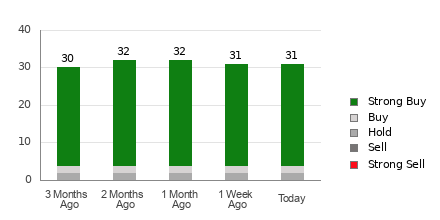US Dollar Weakens Amid Trade Tensions and Economic Updates
The dollar index (DXY00) declined by -0.92% on Wednesday. This drop came as trade tensions with China intensified, particularly after the US government prohibited Nvidia from selling its H20 chips to China. The ongoing tariff conflict is damaging foreign confidence in the dollar, pushing some investors to divest from dollar assets. Losses intensified when the World Trade Organization (WTO) cut its 2025 global trade forecast to a -0.2% decline from an earlier projection of +3.0%.
Retail Sales and Manufacturing Data Show Strength
March retail sales showed a gain of +1.4% month-over-month, aligning with expectations. When excluding automobile sales, retail sales increased by +0.5% month-over-month, outpacing the anticipated +0.4% growth. Additionally, March manufacturing production rose by +0.3% month-over-month, which was better than the expected +0.2% increase.
In the housing sector, the National Association of Home Builders (NAHB) index for April unexpectedly increased by 1 point to reach 40, surpassing forecasts that anticipated a drop to 38.
WTO Revision and Federal Reserve Insights
The WTO has warned that if the United States continues to implement reciprocal tariffs, global trade could contract by -1.5% this year. Cleveland Fed President Hammack stated that a “modestly restrictive” policy is appropriate, emphasizing the Fed’s case to keep interest rates steady while balancing risks.
Federal Reserve Chair Jerome Powell noted that the Trump administration’s tariffs have exceeded the Fed’s higher-end predictions, mentioning that the US economy may stray from the Fed’s objectives of full employment and price stability for the remainder of the year. He suggested a cautious approach until greater clarity emerges regarding the economic outlook and policy adjustments.
Market expectations reflect a reduced likelihood of a -25 basis point rate cut after the upcoming FOMC meeting on May 6-7, now estimated at 16%, down from last week’s 30% chance.
Currency Market Reactions
The EUR/USD (^EURUSD) rose by +1.05% on Wednesday, reacting to the dollar weakness. However, any further euro gains may be limited as reports indicate minimal progress in resolving trade disputes between the EU and the US. Expectations of a potential -25 basis point rate cut by the European Central Bank (ECB) at their Thursday policy meeting may also put downward pressure on the euro, with swaps reflecting a 97% chance of such a cut.
In the currency market, the USD/JPY (^USDJPY) decreased by -0.91%. The yen strengthened, reaching a 6-1/2 month peak against the dollar due to increased safe-haven demand amid the escalating US-China trade war. Support for the yen also came from encouraging Japanese economic data, showing February core machine orders rising by +4.3% month-over-month—significantly surpassing the predicted +1.2% increase.
However, gains in the yen may face constraints following reports that the Bank of Japan (BOJ) plans to lower its economic growth forecast in their upcoming policy meeting. BOJ Governor Ueda remarked that the US tariff policy could generate adverse conditions for the Japanese economy, potentially prompting a response from the BOJ.
Precious Metals Surge Amid Economic Turbulence
In commodities, June gold (GCM25) closed up +106.00 (+3.27%), and May silver (SIK25) increased by +0.683 (+2.11%) on Wednesday. Precious metals rallied significantly, with June gold achieving a contract high, and nearest-futures gold prices hitting a record high of $3,332.10 per ounce. The weaker dollar was beneficial for metals, alongside the plunge in stock prices that fueled safe-haven demand.
The intensifying US-China trade tensions have further spurred demand for precious metals. Following the ban on Nvidia’s sales to China, President Trump announced an investigation into tariffs on critical minerals. Investors are seeking precious metals as a secure asset, particularly given expectations for a rate cut by the ECB and rising geopolitical risks in the Middle East stemming from ongoing conflicts.
As fund purchases of gold have surged, long positions in gold ETFs reached a 1-1/2 year peak on Tuesday, indicating strong market interest in the asset.
On the date of publication, Rich Asplund did not hold (either directly or indirectly) positions in any of the securities mentioned in this article. All information and data in this article is intended for informational purposes only. For more details, please view the Barchart Disclosure Policy here.
The views and opinions expressed herein are solely those of the author and do not necessarily reflect those of Nasdaq, Inc.

